Pocahontas english original
Pocahontas
1596 – 1617
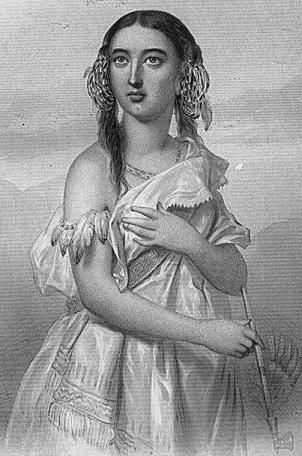
On an April day in 1613, Pocahontas walked the narrow plank leading onto the ship Treasurer, anchored in the
For more than three years, her father, King Powhatan, had forbidden her to have anything to do with the English settlers, and he'd sent her away from
After the group had dinner, Jopassus and his wife took Pocahontas to the gunners' room of the ship, told her to wait a few minutes, and left her. Instead of returning, they disembarked with the copper kettle they'd been paid for luring her onto the vessel.
Time passed, and Pocahontas realized her companions were not coming back. Then the ship began to move. She was a prisoner.
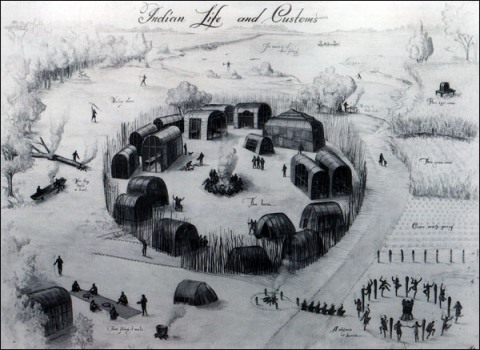
Argall sailed with his hostage back to
Powhatan returned seven captured English settlers and sent the colony one canoe of corn, saying he'd send more after the fall harvest. He continued fighting against other tribes, however, and attacked the outlying areas of the
Pocahontas was sent to live near
The famous Indian maiden was born at the chief settlement of the Powhatan tribe, Werowocomoco, in 1596 or 1597. She was named Matoaka, which meant "Little Snow Feather.' Pocahontas, her nickname, has been translated by the English as "Bright Stream between Two Hills" and by the Powhatans as "Little Wanton.'
Pocahontas's father had become chieftain in 1570 and had taken the tribe's name, Powhatan, as his own name. The Powhatans were part of the Algonquian nation. Ruthless and fierce, Powhatans conquered neighboring tribes, slaughtering the men and taking women and children captive. The tribe practiced torture and dismemberment of their enemies. Coming from this savage background, it is amazing that Pocahontas was able to become friends with the English and convert to their ways.
Chief Powhatan, an absolute dictator, had many wives, each of whom usually bore him only one child. Nothing is known of Pocahontas's mother. Powhatan may have given or sold her to another warrior, even to another tribe. She may have died in childbirth. Pocahontas, born when Powhatan was about fifty, was her father's favorite daughter.
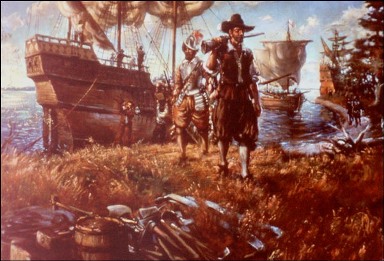
Pocahontas was eleven or twelve when the first three shiploads of white settlers arrived at
In 1585 the governor of
Thus, Powhatan and his people had good reason to mistrust the newly arrived English.
Pocahontas undoubtedly watched as the white-skinned people began building a fort, a storehouse, and a crude church. The settlers were shorter than Powhatan men, and by the native's standards, strangely dressed. While most Englishmen had beards, long hair, and often mustaches, the Powhatan men were clean-shaven and cut all but a single strip of hair across the top of their heads. They scraped their faces and scalps clean with sharpened shells. The Powhatans wore light moccasins or went barefoot; the English workmen ware heavy boots. The whites were called "coat wearers" because they ware several layers of long-sleeved clothing in all but the hottest weather. By contrast, the natives usually wore only small leather aprons or breechcloths that covered only a scant area of the body. Women and men alike went bare above the waist.
Pocahontas was interested in the tools and gadgets the Europeans brought. The Powhatans hunted with bows and arrows and spears, and clubbed their enemies with tomahawks. The killing portion of all these weapons was made of stones painstakingly chipped to sharpness. The natives shaped canoes by setting fire to logs and burning out the center portion. The English, on the other hand, had knives, axes, and saws to build with. They had brought glassblowers to
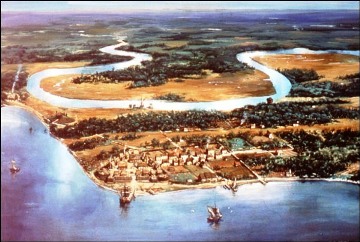
Above all, the English had guns. Powhatan and his warriors had seen the effect of these weapons and wanted to steal same for themselves. Pocahontas looked on all the activity and strangeness with the awe of a child.
Among the colonists was twenty-six-year-old Captain John Smith. Already a veteran of the Turkish wars, he had been captured and made a slave, but he'd managed to escape while awaiting ransom. Despite the mistrust and jealousy of some of the colonists, Smith was one of the eight men chosen by the English king to govern the colony. Although he arrived in
Perhaps because of his military experience in foreign lands, Smith recognized the need to communicate with the Native Americans. When he saw the girl watching, he welcomed her, and by means of signs and objects began to learn a few Powhatan words and to teach her some English words. He also gave her some of the gifts the London Company, sponsor of the expedition, had sent along: glass beads and a bell.
Although Powhatan was impressed with the English guns, they were ill-suited for fighting in
In late June two of the three ships that had come to
Pocahontas noticed the Englishmen's distress and persuaded some friendly Powhatans to bring the settlers corn (maize). Her half brother Pochins brought corn and fish. Smith later told Queen Anne that Pocahontas saved the colony from death and starvation.
Smith realized the colony needed more food than Pocahontas could provide, knowing that at any time she could be prevented from bringing anything at all. He set out with three companions in early December 1607 to explore the
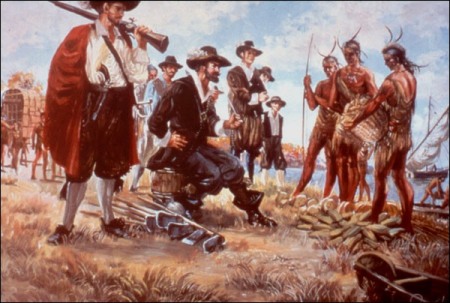
At a point near present-day Providence Forge, Smith went ashore with several native guides, leaving the other three men in the canoe. Within a few minutes he was set upon by Powhatan warriors. Using one of his guides as a shield, he backed away, but tumbled into an icy stream and was captured. Two of his fellow colonists were killed; the third was captured, dismembered, and his body was burned at the stake.
Smith was taken as a captive from one of Powhatans brothers to the other. Each ruled a portion of the Powhatan empire. He was marched to the
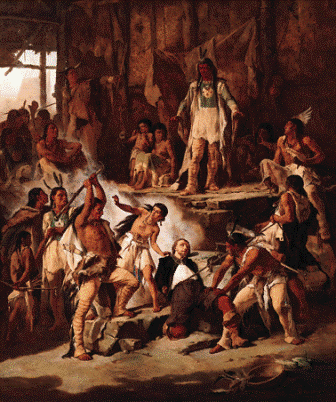
Suddenly Pocahontas came out of the crowd, put her arms around her friend's head, and laid her head down on his. Powhatan honored a tradition and spared Smith's life. Smith was adopted into the tribe in a ceremony two days later, and then escorted back to
Because she had saved him, Pocahontas was now, according to tradition, the guardian of Smith; his life was hers to do with as she wished.
Some historians have suggested that Pocahontas might have been disappointed that Smith did not marry her, but she was still a child by English standards. Others have said that Smith invented the story of his rescue. He was, however, the only survivor of the ill-fated exploration, and Pocahontas did spend a great deal of time in
Pocahontas also often came to
Although still a child, Pocahontas was a princess who acted as a go-between for her father and the colonists. She reported to her father when a shipload of a hundred additional colonists arrived in January 1608, which contradicted Smith's claim that the settlers were only in
Captain
In the autumn of 1608, Smith was elected president of the council governing
When Captain Newport next visited Powhatan, he brought him a scarlet cloak and a European bed and other furniture. He also crowned Powhatan king of the Indians, despite Smith's objections. Smith thought all the generosity and elevation would make Powhatan more difficult to deal with, especially when the ship arrived with more hungry settlers late in the year. More food would be needed, and the growing season was past.
Smith was right. Powhatan now seemed more interested in fighting than trading, and when Smith tried to barter corn from the Nansemond tribe, he found that Powhatan had told them not to trade with the English. The chieftain seemed determined to get rid of the colonists. Before 1608 ended, Powhatan forbade Pocahontas to have anything to do with the English, or risk death. But she was twice more to aid the colony, putting her own life in jeopardy.
The situation at
Meanwhile, despite Smith's instructions to the settlers to stay close to the fort, a group had gone hunting to
Smith strengthened the colony, but in July 1609, Captain Argall returned with news that the council had been abolished, a governor-for-life would soon arrive, and two of Smith's earlier enemies were returning to
Smith left
The colony was thus without Smith and Pocahontas, two who had been responsible for the earlier peace and success. In an ambush later that year, Powhatan warriors killed sixty colonists. The remainder had little food, and that period in
Three years passed. The colony thrived and expanded, but the danger of attack always worried them. They thought if they could kidnap Pocahontas, they might force Powhatan to make peace. Captain Samuel Argall was sent in the Treasurer up the
Under the direction of the Reverend Alexander Whitaker and others, Pocahontas was taught Christianity. Although she could not read or write, she spoke English. She memorized portions of The Book of Common Prayer; expressed her faith, and was baptized in the spring of 1614 with the Christian name of Rebecca.
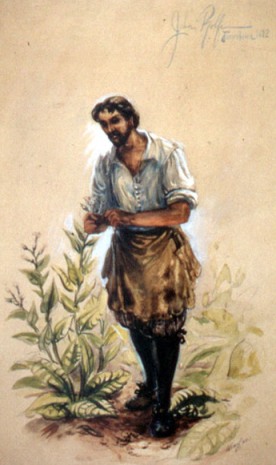
While at Henrico, eighteen-year-old Pocahontas met a widowed farmer named John Rolfe, ten years her senior. Rolfe and his wife had been shipwrecked in Bermuda on the way to
Rolfe was interested in growing tobacco, and Pocahontas showed him how the natives cultivated the crop. He saw the attractive maiden not only at work, but at church as weIl. Rolfe fell in love with Pocahontas, despite their differences.
In 1614 Rolfe wrote Governor Dale, asking permission to marry Pocahontas. He detailed all the reasons against the marriage: her lack of education; her barbaric background, the long-standing taboo against a mixed marriage, even the Biblical admonition against marrying "strange wives.” Still, he wrote, he was besotted with her. He assured the governor that the marriage would not be for carnal reasons only, but for the good of the colony and for the good of his soul.
Dale quickly agreed to the marriage. Perhaps this would be just the thing to heal relations between the two races. He accompanied Rolfe and Pocahontas on a visit to Powhatan, who sent two of his sons to meet them. Pocahontas told her brothers she was grieved that her father had been unwilling to give up his weapons to ransom her and that she liked the English so much that she planned to marry and star with them.
To Dale's surprise, Powhatan gave permission for the marriage, but he did not attend the ceremony, held in
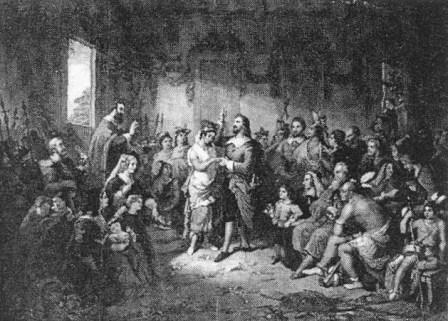
The newlyweds lived on a plantation on the James River between Henrico and
After his daughter's marriage, Powhatan made peace with the English that lasted the remainder of his lifetime.
In 1615 Pocahontas and John Rolfe had a son they named Thomas. In appreciation of all the good Pocahontas had clone for the colony, the Virginia Company - a group of investors who financed colonization in Virginia - voted to give her and her son an annual stipend. The only person not pleased with this was King James, who declared that Rolfe had committed treason by marrying the daughter of a pagan king.
The following year the Virginia Company invited the Rolfes to visit
On June 12, 1616, the Rolfes arrived in
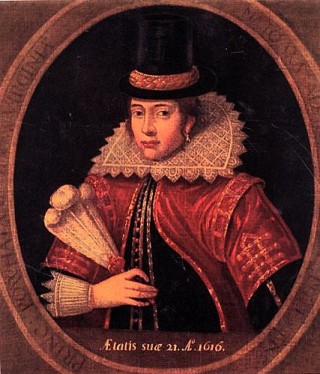
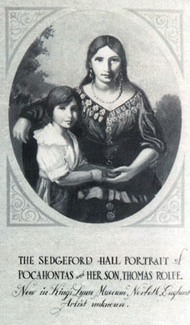
Everywhere the Rolfes went, Pocahontas was welcomed, feted, and praised. When Pocahontas began to suffer respiratory problems, the Rolfes left
The Rolfes next visited John's family home, Heacham, so his family could meet Rolfe's wife and son. After a few weeks the Rolfes returned to the tiring
At Gravesend, while waiting for their departure to
The
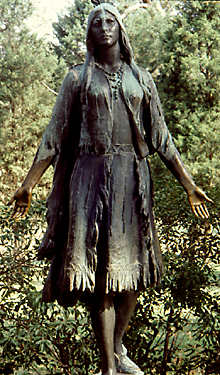
Pocahontas Statue in Jamestown.... near to John Smith Statue....
Verantwortlich für den Inhalt dieser Seite ist ausschließlich der
Autor dieser Homepage, kontaktierbar über dieses Formular!